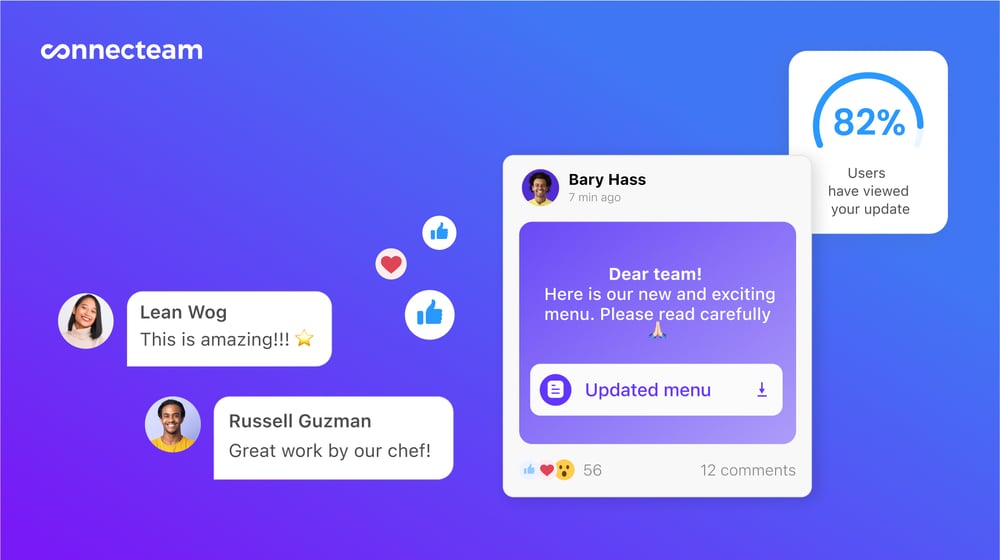By implementing the tips outlined in this blog you’ll be able to supercharge your communication efforts and make it easier than ever to keep your teams engaged, informed, and connected.
In the dynamic landscape of modern business, effective communication is the cornerstone of efficiency, productivity, cohesion, and, ultimately, the success of any organization.
But what is organizational communication, and how can you ensure efficient communication within your company?
Let’s take a closer look at organizational communication and explore six practical tips on how to master it.
What Is Organizational Communication
Organizational communication, within the framework of communication theory, refers to the process of exchanging information, ideas, messages, and feedback within an organization.
It involves all forms of communication, both formal and informal, among individuals, teams, and departments within an organization.
Organizational communication is essential for facilitating the flow of knowledge, aligning goals, and maintaining a healthy work environment.
🧠 Did You Know?
Companies with effective organizational communication are 3.5 times more likely to outperform their peers? Clear and effective communication is a key driver of employee engagement and business success.
Types of Organizational Communication
We can divide the field of organizational communication into the following four types:
Formal communication
Formal communications refer to official company actions to share information and align everyone with business goals.
This can, for instance, be staff meetings to introduce new products, a company handbook on standard operational procedures, or a press release distributed to the public.
While it essentially involves clear, specific, and structured information exchange, a company can also present formal actions more casually, like through social media posts.
Informal communication
Informal communication, also called ‘grapevine communication,’ is any interaction outside an official communication structure.
This can be any type of interpersonal communication, such as conversations, chats, phone calls, and ‘water cooler talks’ without any formality.
For simple questions, it’s often quicker to informally ask a coworker or manager instead of going through a formal process like submitting a support ticket.
Horizontal communication
Horizontal communication occurs between individuals, teams, or groups at the same level of the company hierarchy.
With employees interacting with their peers and team members, organizational communication plays a vital role in bridging silos and improving cross-departmental collaboration in the workplace.
Vertical communication
Vertical communication refers to communication that occurs in an up-and-down vertical pattern and is vital for sharing guidelines, feedback, or ideas.
We can break this form of communication down into the following two directions:
4.1 Upward communication
Upward communication occurs when staff communicate with a higher-ranking official, like their manager.
It’s important for everyone to understand the organization’s policies on addressing senior staff and to provide methods of sharing any concerns or suggestions with higher-ups.
4.2 Downward communication
Downward communication flows from higher levels of management or leadership to lower levels within the organizational structure.
It typically involves sharing information, instructions, goals, policies, and decisions. It’s, therefore, essential for keeping everyone aligned and informed on the organization’s vision, objectives, and guidelines.
The Importance of Organizational Communication
Effective organizational communication plays an essential role in any company’s success.
Ways in which organizational communication supports this include:
- Streamlining the flow of information within the company.
- Aligning employees with the organization’s mission, vision, and core values.
- Helping staff see the larger picture of how their work contributes to the company’s success.
- Enhancing communication and collaboration across teams and departments.
- Strengthening relationships between employees and their managers.
- Reducing misunderstandings and the spreading of misinformation within the organization.
- Fostering a positive work environment where employees have a voice, boosting employee morale, job satisfaction, engagement, and trust in the workplace.
- Boosting employee engagement by keeping the entire workforce better informed and connected.
- Making processes and procedures more efficient, in turn reducing costs.
- Improving employee productivity by allowing staff to easily and quickly find relevant information whenever needed.
6 Tips for Effective Organizational Communication
Now that we’ve covered organizational communication and its benefits, let’s dive into how you can create successful organizational communication strategies at your organization.
Align organizational communication & business strategy
Linking organizational communication to your business strategy is essential to keeping everything running smoothly.
To develop an effective organizational communication strategy, start by linking communication to your overall strategic plan, including the company’s mission, vision, and values.
If your business strategy, for instance, aims to enhance staff performance through improved employee retention and engagement, your organizational communication strategy should be closely tied to this objective.
💡 Pro Tip:
Regularly update your communication strategy to reflect any changes in business goals. Connecteam’s team chat app can help you easily adapt and disseminate new strategies across your entire organization.
Connect your entire workforce
Every employee should be involved and participate in organizational communication.
Instead of just delivering messages top-down, effective internal communication requires two-way conversations where employees can voice issues, questions, comments, ideas, and concerns.
Your entire company plays a vital role – from senior management maintaining effective company-wide communication to human resource professionals ensuring employees’ expectations are met.
This promotes a healthy organizational culture, builds loyalty, and drives employee productivity.
Keep content relevant & engaging
If you’re sending out mass newsletters and expecting all employees to read them, chances are they’re not.
One common pitfall in organizational communication is the failure to segment audiences based on their roles, departments, locations, and preferences.
When everyone receives the same information, regardless of its relevance to their specific responsibilities, it results in ‘information overload,’ causing engagement and consumption rates to plummet. As a result, employees may disregard messages as irrelevant to them and overlook critical updates.
Therefore, define and understand your audiences to ensure your communication efforts effectively reach their intended recipients.
🧠 Did You Know?
Connecteam’s employee chat lets you create smart groups that automatically add people based on their job, departments, seniority, or any other characteristic you choose. This way you can easily make sure you send information to the relevant groups of people.
Use the right communication channels
Beyond having the right content, knowing your audience, and communication skills, it’s important to choose the right communication channels.
However, the number of communication channels used in the workplace continues to grow – think of intranet, email, private messaging apps, document-sharing platforms, and project management tools.

Choosing the right one has, therefore, become complex, making it hard to manage organizational communication efficiently.
Invest in a modern communication solution
If you’ve noticed low engagement levels with your current communication methods, it’s time for a change.
To streamline organizational communication, many organizations are adopting modern employee communication solutions that consolidate all organizational communication channels into a single accessible platform.
This way, you can effectively reach your entire workforce and always make important information available to them.
With many traditional communication methods, like intranets, becoming outdated and no longer aligning with employee preferences for communication, modern employee communication solutions are a must-have.
📚 This Might Interest You:
We put together a list of the best team communication apps to help you align your team.
Measure & improve
Tracking and measuring your internal communication efforts is vital to identify what’s working well and what needs improvement.
By doing so, you can measure employee engagement rates with your internal communication, identify the most effective communication channels, gauge which types of content resonate the most with employees, and recognize the employees who engage with your content most frequently.
Leveraging this data will enable you to make informed improvements and enhance your organizational communication strategy for the future, ultimately leading to more effective internal communication.
Boosting Organizational Communication with Connecteam
Connecteam is a great example of an employee communication app that makes it easy to efficiently communicate with your team and keep everyone engaged and informed, no matter where they’re working from.
Its vast organizational communication features – such as the in-app chat, company feed, and knowledge base – allow you to instantly reach all relevant employees, share important news and updates, and put all relevant information at their fingertips.

On top of that, Connecteam gives you, as a manager, a clear overview of who received, confirmed, and engaged with sent content, allowing you to ensure you get your message across effectively.
And that’s just the tip of the iceberg!
Bottom Line on Organizational Communication
Effective organizational communication is an essential component that connects your entire workforce, aligns goals, and propels companies toward success.
By implementing the tips outlined in this blog and investing in a cutting-edge solution like Connecteam, you’ll be able to supercharge your communication efforts and make it easier than ever to keep your teams engaged, informed, and connected.




